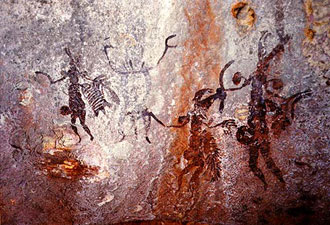 Several years ago I wrote an article for Josse Ford’s Art Blog about the fascinating cave art of the Bradshaw People in Northwestern Australia….
Several years ago I wrote an article for Josse Ford’s Art Blog about the fascinating cave art of the Bradshaw People in Northwestern Australia….
Having grown up and spent most of my life in Australia, I have always been drawn to the wild red desert areas – like a spiritual calling I guess you could say. I found this discovery of extremely ancient cave art in the Kimberley Ranges of North West Australia incredibly interesting – not just because of the beautiful art, but also because of the suggestion of:
“the existence of an advanced culture with sophisticated intellect and social organization well before the history of civilization, as we know it.”
Along the seven rivers of the rugged Kimberley Ranges, enigmatic rock paintings, protected by shallow caves and overhanging ledges, confront the skilled survivors visiting the harshest and most inhospitable place on Earth. The pictures bear witness of an advanced civilization that existed long before the ancient cave paintings of Europe, long before man is believed to have acquired the intellect of expressing concepts in art.
These are the Bradshaw Paintings also known as Gwion Gwion by the local Aboriginal people.
Skilled and realistic representations of portraits, highly choreographed group actions, and seemingly emotional interactions of two tell about an advanced civilization that existed in the last Ice Age, or probably as long ago as one Ice Age before. Photo enhancements show the compositions were designed and sketched before the artists filled in the paint. Furthermore, the pictures were retouched, indicating a long lasting tradition and appreciation of the paintings.
The Bradshaw Paintings are incredibly sophisticated, yet they are not recent creations but originate from an unknown past period which some suggest could have been 50,000 years ago.
……Peter Robinson, Project Controller of the Bradshaw Foundation.
In 1996 one of the paintings was dated by analyzing an ancient wasp nest covering it (using thermoluminescence). The nest was found to be over 17,000 years old, indicating that some paintings are at least this old. Debate rages as to who actually created the art. On one side of the debate is Grahame Walsh, an amateur archeologist and the leading expert on the Bradshaws with over 1.2 million images he has amassed over 21 years studying them. His hypothesis claims that the Bradshaws were painted by a culture predating present day Indigenous Australians. On the other side are the mainstream scientific community who believe that it is completely plausible that the art was produced by the local people.
The rock paintings were discovered by Joseph Bradshaw and his brother in 1891. The new settlers had set out to find grazing land for their cattle and became lost in the rugged Kimberley Ranges. Since the initial find by the Bradshaw brothers, over 1,000 paintings have been discovered. The painted sites extend in an area of about 50,000 square kilometres.
Fascinating story don’t you think? Who were they and where did their obvious sophistication and sensitivity come from? And – I’m also wondering what art marketing looked like back then? (Sorry – I couldn’t resist thinking that!).
The original article that I used for source material is no longer online. However you can find out more about the Bradshaw Paintings at Convict Creations and The Bradshaw Foundation and of course Wikipedia.